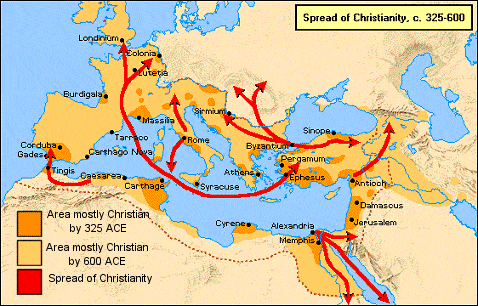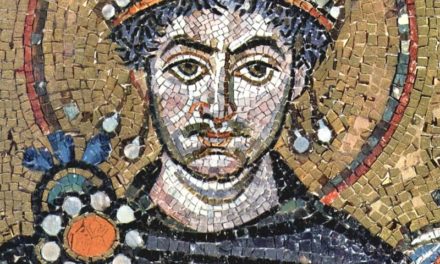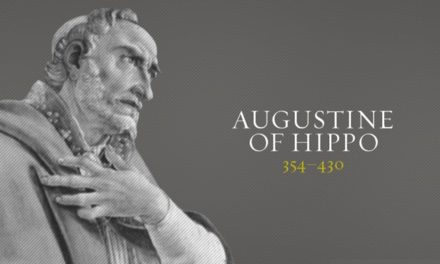This Episode’s title is – “Expansion ”.
We’re going to spend a little time now tracking the expansion of the Faith into different areas during the Early Middle Ages.
We ended last time with the story of the conversion of the Frank king Clovis in 496. When he was baptized on Christmas Day by Bishop Remigius of Rheims {Reems}, 3,000 of his warriors joined him. It was the first of several mass baptism that took place during the Middle Ages in Europe. And it raises the issue of the paganizing of Christianity.
The task of Missions usually proceeds in 1 of 2 ways.
The first & more common route is that of individual conversion. Though in the NT we find converts being called into immediate baptism, it wasn’t long before conversion was followed by a period of instruction before baptism. That time for instruction in the basics of the Faith could be either short or long, depending on the standards of the bishop or community of believers. This form of missions, that of individual conversion & baptism was the method used by the Church for the first 3 Cs, & by most Protestant missions from the 19th C to today. That’s because of the emphasis on an individual change of heart in Evangelicalism. While this certainly finds support in Scripture, it can miss an important dynamic when people convert to Christ out of a pagan culture. Their change in faith almost certainly means being uprooted from that culture; sometimes leading to the need to physically relocate to an area where their faith will not endanger their life or the lives of their family.
For that reason, another method of Missions has sometimes been used; that of mass conversion, where an entire group of people make a communal decision to forsake their old religion in favor of Christianity.
Now, I suspect some of those listening will respond to this idea of mass conversion with distaste. Evangelicalism has placed such an emphasis on personal salvation that the idea of the conversion of an entire community at once is highly suspect. We often talk of receiving Christ as one’s PERSONAL Savior. So the idea that an entire village or tribe would turn to faith in Christ at once seems disingenuous.
But consider this: The idea of personal, individual freedom is in many ways a distinctly modern, western & democratic concept. Even in our own time, much of the world has little concept of personal or individual freedom. They understand themselves as part of a family, village, or tribe; as a member of a community of people where autonomous individuality is regarded as dangerous & a threat to the survival of the group. For much of history and a good part of the world, the idea that you would change your religion all on your own while everyone else believed in other gods was simply unthinkable. Conversion would enrage the old gods & so endanger your family & neighbors. This was something several Roman Emperors used as a reason for opposing Christianity.
Some Christian missionaries realized the key to the conversion of these communal pagan peoples was to win the leader. Because his choice was nearly always adopted by the entire tribe. To be sure, these missionaries understood salvation was an individual issue. But they knew the key to being able to work for individual salvations was to win the leader, who would in turn lead his people in a mass conversion. Then they could be free to work the faith into the lives of the people in a more intimate & personal way.
The downside to mass conversion is obvious. Many who formally converted by being baptized, never went on to a real faith in Christ. They took the label of Christian without ever being genuinely converted. What made this especially troublesome was when it was the ruler who feigned conversion. Some did for purely pragmatic ends. Submitting to baptism often brought them political & economic gain. Mass conversions might make it easier for genuine converts to practice a new worldview, but it also imperiled the Faith because the unconverted brought with them old superstitions, blending them into Christianity in a syncretistic religious amalgam.
This was the case with the Frank king Clovis. He went through the motions of conversion, but Jesus remained little more for him than a divine warlord.
Gregory of Tours, who lived a century after Clovis, was his main biographer. Gregory says even after his conversion, Clovis used deceit, cunning, & treachery to expand his kingdom. He sent bribes to nobles and those responsible for protecting a rival king to betray him. He told another king’s son if he killed his father, Clovis would support the son’s ascent to the throne & make an alliance with him. The son did as Clovis hoped & killed his father. Clovis them promptly announced the son guilty of the heinous crimes of patricide & regicide & took over his realm.
As Dan Carlin likes to point out in his Hardcore History podcast-episode, Thor’s Angels, when you think of the Goths & the Franks of this time, think of a modern criminal biker gang. You’re not far off the mark in what these Germanic barbarians were like; in both mindset & appearance. When Clovis submitted to baptism, all he did was trade in his black leather vest for a navy blue one.
Among the barely converted Franks & other Germanic tribes, long-dead saints stepped in to replace their numerous deities. Each saint adopted a role the old gods had performed. St. Anthony took care of pigs, St. Gaul looked after hens, Apollonia cured toothaches, Genevieve cured fever, and St. Blaise soothed sore throats. For every human need the Germans posted a saint to take care of it.
Many tales circulated about the miraculous powers of these saints. One told of 2 beggars, 1 lame, the other blind. They got caught up in a procession of the devoted who carried the relics of St. Martin. But these 2 beggars made their living off the alms of the pious & didn’t want to be healed. Fearful lest they be cured by their proximity to the relics, they quickly struck a deal. The 1 who could see but not walk mounted the shoulders of the 1 who could walk but not see & they tried to exit the procession. They weren’t able to get away quickly enough; both were healed. è Such stories were plentiful.
As with Constantine the Great in the early 4th C, we can’t be certain if Clovis’ conversion was real or feigned. Certainly much of his behavior after his baptism is doubtful. But the political benefits of conversion were certainly not lost on him. Clovis was a man of huge ambition. He wanted to be more than a chieftain of the Franks. He wanted to be king, a chief of chiefs. He knew he needed to distinguish himself among the many competing power centers in Western Europe. By joining the Roman Church he set himself apart from the other Germanic kings who were all Arian. This move secured the support of the Gaelic-Roman nobility throughout Gaul.
Clovis was the first leader of the Franks to unite the tribes under one ruler, changing the leadership from a group of chieftains to rule by kings, ensuring the royal line was held by his heirs, known as the Merovingians.
Not long after his baptism and the quick following by 3000 of his warriors, Clovis pressed other Frank nobles to convert & join the Roman church. He understood the religious unity of the kingdom was crucial in staving off assault, and to further campaigns to enlarge their borders. Wars of conquest became a means of “liberating other people from the error of Arianism.” And the church at Rome was not at all averse to having an armed force on its side.
Clovis wasn’t all that successful in expanding his borders south & east into the region of the Burgundians, but he was able to push the Visigoths out of Gaul, confining them in Spain. In the Battle of Vouille {Voo-yay}, the Visigothc King Alaric II was killed. In appreciation for his service in defeating the Visigoths, the Eastern Emperor Anastasius I declared Clovis Consul, a provocative title as it was reminiscent of ancient Roman leaders.
Clovis made Paris the new capital of the Frank kingdom & built an abbey dedicated to Sts. Peter & Paul.
Not long before he died, Clovis called the First Council of Orléans, a synod of 33 Gallic bishops. The goal was to reform the Church & forge an enduring link between the Crown and Church. The Council passed a little over 30 decrees that brought equality between the Frank conquerors and their Gallic subjects.
Clovis died in the Fall of 511, leaving the kingdom to his 4 sons. Unlike Alexander the Great who made no provision for dividing his empire among his 4 generals, Clovis carved up Gaul into 4 regions, one for each son; Rheims, Orléans, Paris & Soissons. Clovis naively thought this would keep them content & result in peace. In truth, it ushered in a period of disunity which lasted to the end of the Merovingian dynasty in the mid-8th C.
In Episode 37 we looked at the 5th C Irish missionary Patrick. The Irish had never been a part of the Roman Empire. Though they had frequent contact with Roman Britain, the Irish Celts were culturally, economically, & politically different. When the Roman army abandoned Britain as too costly & difficult to defend, the Church filled the vacuum. The spiritual outreach to Ireland was primarily the work of Patrick, who though British, planted a church in Ireland that remained independent of the Roman Catholic Church.
Patrick understood the evangelistic dynamic of the Christian faith & discerned that it alone offered what the native Druids could not: Peace to a land troubled by constant tribal warfare. Patrick’s strategy was to win the tribal leaders to Christ. Many local lords became Christians. Because of the way Celtic society was arranged, when rulers converted, so did those they ruled.
Ireland was ripe for the message & offer of the Gospel. The religion practiced by the Druids was a brutal, demonic, religious terrorism that many of the common people were eager to cast off. The Gospel was about as OPPOSITE a message & offer from Druidism as one can imagine. There are estimates of as many as 100,000 genuine converts to Patrick’s ministry.
On the foundation of faith & church life Patrick laid, Finnian of Clonard built a pattern for Irish monasticism in the early 6th C. Monasteries were founded all over Ireland. As they rose in number and prestige, the ecclesiastical organization Patrick established withered away. By the end of the 6th C the Irish church had become a church of monks. Abbots replaced bishops as the leaders of the Church. From the outset, Irish monks valued scholarship & an energetic spread of the Gospel.
Interestingly, there’s evidence that the missionary fervor that stands as one of Celtic Christianity’s major traits may have been due to their system of penance. In an earlier episode we saw how the early church developed a view of repentance that included penance. The idea was that repentance needed to be demonstrated by some act showing contrition. The theology went like this: Repentance was a heart issue only God could see. But John the Baptist had said, “Bring forth fruit worthy of repentance.” So, when people repented, their account before God was cleared. But how about restoring them to the Community of faith – fellowship in the Church? While man can’t see the heart, he can see the actions that flow from that heart. Penance became a system of works people could perform that would mark repentance. It didn’t take long before lists were made of what penance was due for what sins. One of the forms of penance Celtic Christians practiced was exile, banishment from their homes. Some of the intense missionary activity of the Celtic Christians was motivated by this form of penance.
Irish scholar-monks ranged far and wide across Europe during the 6th & 7th Cs. This aggressive missionary activity of the Celtic Church eventually caused trouble since it remained independent from Rome. Churches started by Irish missionaries were often located in regions that later came under the control of Rome.
In 636, south Ireland decided to fold their church community into the Roman Church. Then in 697, the church in Northern Ireland decided to follow suit. Though most of Celtic Christianity was eventually folded into Roman Catholicism, isolated communities scattered across Scotland, Wales & the British Isles continued their independence for many years.
One of the Celtic-English missionaries who had a huge impact in Northern Europe was Boniface.
Born Winfrid in the Anglo-Saxon kingdom of Wessex in the early 670’s, his family was prosperous and sent him to school at a monastery in Exeter. The life of the monks appealed to Winfrid & against his father’s wishes, he decided to pursue a religious career. He showed a mastery of the Scriptures & great skill in teaching & organization, traits sought after in monastic life. For further training he moved to a Benedictine monastery in Hampshire. This monastery was led by a brilliant abbot who’d made it an industrious center of scholarship. Winfrid soon became a teacher in the monastery school & at the age of 30 was ordained as a priest. When the abbot died in 716, the logical choice to replace him was Winfrid. In a surprise move, he declined, and left for the region of Frisia, what today we know as The Netherlands.
Winfrid had a passion to take the Gospel of Christ were it was yet to be planted. He’d heard of a similarly-minded missionary named Willibrord who worked in Frisia & needed help. They spent a year together but when war broke, both returned home.
A year later, Winfrid went to Rome seeking an audience with Pope Gregory II. He shared his vision of seeing the Germanic tribes delivered from their Arian heresy into the Catholic faith. Gregory replied, “You glow with the salvation-bringing fire which our Lord came to send upon the earth.”
The Pope renamed him ‘Boniface’ after the 4th C martyr Boniface of Tarsus, & appointed him as the missionary bishop for Germania. This meant Boniface was a bishop without a diocese. The realm of his ministry had no churches. It was up to him to carry the light of Christ to the superstitious Germanic tribes. Boniface never returned to England.
He focused his work in the regions of Hesse & Thuringia, leading thousands to Christ. He planted scores of churches.
While the Germans were nominally Arian, entire regions were in reality still pagan, worshiping the ancient German gods and practicing superstitious rites. Boniface found some supposedly Christian missionaries as he made his way through Germany but they espoused heresy. It was little wonder they’d had little impact. When he confronted them, they resisted. So Boniface had them arrested & confined. He soon gained a reputation for being stern & determined.
One story from Boniface’s career is legendary. Whether or not it’s factual is unknown. It’s certainly not difficult to believe that a man who would go to Rome & ask for permission to single-handedly carry the Gospel to heretics & pagans might do something like what we’re about to hear.
The story goes that Boniface went to Geismar in Hesse where the Donar or Thor’s Oak stood. As was common for Germans, they considered trees and forests to hold great spiritual power. Thor, god of thunder, was the chief deity in their pantheon. The Donar Oak was dedicated to his power and glory. Boniface knew there was no Thor & that there’d be no backlash if he chopped down a tree. Some Germans might protest & take it on themselves to defend Thor’s honor. So Boniface called them to gather round, then set them this challenge—let Thor, that mighty god of thunder, defend his tree himself. Certainly a god as great as the god of thunder could deal with a puny little Christian priest. Unless, à there was no Thor & the Christian faith was true. Boniface lifted his axe and began to strike. No lightening followed. No thunder shook the ground. But according to his early biographer Willibald, after Boniface had taken a dozen or so swings at the oak, a strong wind kicked up that knocked it over. It fell & broke into 4 pieces, revealing that it was in fact rotten. The message was clear; the old ways were like that rotten oak. The people were stunned and as though being released from a prison in which they’d long been held, renounced their belief in the old gods & in-mass converted to Christianity. Boniface used the wood from Donar’s Oak to build a church.
His skill in administration brought a remarkable level of organization to the now rapidly growing German church. In 732 he was made archbishop over Germany. He worked for an educated, disciplined, & pure clergy; something he knew in other part of the Europe was not the case. He tolerated neither laziness nor incompetency among clerics & purged the lingering rites of German paganism from church rituals. The syncretism that had been adopted in many other places, whereby pagans rites were absorbed into church traditions, was not something Boniface allowed. Using missionary volunteers from England, many of whom were women, he advanced organization and structure in the German church and filled it with zeal for obedience, service, and outreach.
Along with his administrative and missionary work, Boniface built monasteries throughout Germany. The most influential was at Fulda, the geographical center of Germany.
No church councils had been held in the Frankish realm for decades before his arrival. Boniface convened 5 of them between 742 and 747. At his urging these Councils adopted strict regulations for clergy and condemned local heretics.
Boniface was a Benedictine monk. The Benedictines emphasized poverty, moral purity, & obedience to Christ. Benedict’s Rule was the norm for monasteries throughout Europe at that time. They were places of worship, devotion, prayer, & scholarship—oases of culture & civilization in the midst of godlessness. Monks copied Scriptures and early Christian literature. Monasteries were about the only educational centers during the medieval period. Had it not been for them, there would have been no Renaissance. The monasteries are where all the learning was kept that formed the intellectual base the Renaissance came from. Sadly, over the centuries, many monasteries forsook their spiritual roots & became places of immorality & corruption. Those Boniface founded for the most part remained places of education, hospitality, & missionary outreach.
Boniface understood all his work could turn to naught if war came. So he worked to nurture peaceful relations between the Franks, Germanic tribes & the Church. He was crucial in negotiating a treaty between the Pope & the Frank king Pepin that would eventually grow into a powerful church-state alliance later in the Middle Ages.
After years of ministry in Central Germany, Boniface again felt Frisia in the North calling him. This was the place where he’d first tried his hand in missionary work. Now, in his late 70’s, he resigned his post as the archbishop of Mainz [Mines] to head north once again. He and his followers roamed the countryside destroying pagan shrines, building churches, & baptizing thousands.
A group of new converts was supposed to meet Boniface & his 52 companions at Dorkum. While Boniface waited for them, a band of outlaws arrived. In his earlier travels, Boniface went with an armed guard commissioned by the Frank ruler. Now he was in a realm beyond Frank control. At the first council he’d called years before, he’d pressed to disallow the clergy from carrying arms. All he had to defend himself was the large wood-covered book he was reading. He wielded it as a shield. As he batted away the thrusts of the outlaws trying to stab him, I wonder if he regretted his previous position. A book makes a poor shield, even if its cover is quarter-inch thick. Boniface & his entire party were slaughtered there on the shore of a river. When the converts arrived to meet up with him, they found his body, & next to it lay a copy of Ambrose’s à The Advantage of Death, with deep slashes in it. The book is on display in Fulda.






